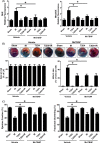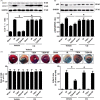Hypertrophic Preconditioning Attenuates Myocardial Ischaemia-Reperfusion Injury by Modulating SIRT3-SOD2-mROS-Dependent Autophagy
- PMID: 33973685
- PMCID: PMC8249780
- DOI: 10.1111/cpr.13051
Hypertrophic Preconditioning Attenuates Myocardial Ischaemia-Reperfusion Injury by Modulating SIRT3-SOD2-mROS-Dependent Autophagy
Abstract
Background: Ischaemic preconditioning elicited by brief periods of coronary occlusion and reperfusion protects the heart from a subsequent prolonged ischaemic insult. Here, we test the hypothesis that short-term non-ischaemic stimulation of hypertrophy renders the heart resistant to subsequent ischaemic injury.
Methods and results: Transient transverse aortic constriction (TAC) was performed for 3 days in mice and then withdrawn for 4 days by aortic debanding, followed by subsequent exposure to myocardial ischaemia-reperfusion (I/R) injury. Following I/R injury, myocardial infarct size and apoptosis were significantly decreased, and cardiac dysfunction was markedly improved in the TAC preconditioning group compared with the control group. Mechanistically, TAC preconditioning markedly suppressed I/R-induced autophagy and preserved autophagic flux by deacetylating SOD2 via a SIRT3-dependent mechanism. Moreover, treatment with an adenovirus encoding SIRT3 partially mimicked the effects of hypertrophic preconditioning, whereas genetic ablation of SIRT3 in mice blocked the cardioprotective effects of hypertrophic preconditioning. Furthermore, in vivo lentiviral-mediated knockdown of Beclin 1 in the myocardium ameliorated the I/R-induced impairment of autophagic flux and was associated with a reduction in cell death, whereas treatment with a lentivirus encoding Beclin 1 abolished the cardioprotective effect of TAC preconditioning.
Conclusions: The present study identifies TAC preconditioning as a novel strategy for induction of an endogenous self-defensive and cardioprotective mechanism against cardiac injury. Specifically, TAC preconditioning reduced myocardial autophagic cell death in a SIRT3/SOD2 pathway-dependent manner.
Keywords: SIRT3; autophagy; hypertrophic preconditioning; ischaemia-reperfusion injury.
© 2021 The Authors. Cell Proliferation Published by John Wiley & Sons Ltd.
Conflict of interest statement
None.
Figures








Similar articles
-
Hypertrophic preconditioning attenuates myocardial ischemia/reperfusion injury through the deacetylation of isocitrate dehydrogenase 2.Sci Bull (Beijing). 2021 Oct 30;66(20):2099-2114. doi: 10.1016/j.scib.2021.04.008. Epub 2021 Apr 20. Sci Bull (Beijing). 2021. PMID: 36654268
-
Hypertrophic preconditioning attenuates post-myocardial infarction injury through deacetylation of isocitrate dehydrogenase 2.Acta Pharmacol Sin. 2021 Dec;42(12):2004-2015. doi: 10.1038/s41401-021-00699-0. Epub 2021 Jun 23. Acta Pharmacol Sin. 2021. PMID: 34163022 Free PMC article.
-
Hypertrophic preconditioning cardioprotection after myocardial ischaemia/reperfusion injury involves ALDH2-dependent metabolism modulation.Redox Biol. 2021 Jul;43:101960. doi: 10.1016/j.redox.2021.101960. Epub 2021 Mar 31. Redox Biol. 2021. PMID: 33910156 Free PMC article.
-
The novel relationship between Sirt3 and autophagy in myocardial ischemia-reperfusion.J Cell Physiol. 2019 May;234(5):5488-5495. doi: 10.1002/jcp.27329. Epub 2018 Nov 28. J Cell Physiol. 2019. PMID: 30485429 Review.
-
Remote ischaemic preconditioning: underlying mechanisms and clinical application.Cardiovasc Res. 2008 Aug 1;79(3):377-86. doi: 10.1093/cvr/cvn114. Epub 2008 May 2. Cardiovasc Res. 2008. PMID: 18456674 Review.
Cited by
-
Luteolin reduces necroptosis in the diabetic heart after cardiac arrest and resuscitation by activating sirtuin 3.Front Nutr. 2025 Jun 25;12:1626020. doi: 10.3389/fnut.2025.1626020. eCollection 2025. Front Nutr. 2025. PMID: 40635895 Free PMC article.
-
Resveratrol targets mitochondrial USP36-SOD2 to induce autophagy-ferroptosis and inhibit gastric cancer progression.Gastric Cancer. 2025 Jul 12. doi: 10.1007/s10120-025-01645-3. Online ahead of print. Gastric Cancer. 2025. PMID: 40650854
-
The Current State of Research on Sirtuin-Mediated Autophagy in Cardiovascular Diseases.J Cardiovasc Dev Dis. 2023 Sep 6;10(9):382. doi: 10.3390/jcdd10090382. J Cardiovasc Dev Dis. 2023. PMID: 37754811 Free PMC article. Review.
-
A bibliometric analysis of myocardial ischemia/reperfusion injury from 2000 to 2023.Front Cardiovasc Med. 2023 Jun 13;10:1180792. doi: 10.3389/fcvm.2023.1180792. eCollection 2023. Front Cardiovasc Med. 2023. PMID: 37383699 Free PMC article. Review.
-
Regulation of the SIRT3/SOD2 Signaling Pathway by a Compound Mixture from Polygonum orientale L. for Myocardial Damage.Pharmaceuticals (Basel). 2024 Sep 27;17(10):1288. doi: 10.3390/ph17101288. Pharmaceuticals (Basel). 2024. PMID: 39458930 Free PMC article.
References
-
- Anderson JL, Morrow DA. Acute myocardial infarction. N Engl J Med. 2017;376(21):2053‐2064. - PubMed
-
- Cung T‐T, Morel O, Cayla G, et al. Cyclosporine before PCI in patients with acute myocardial infarction. N Engl J Med. 2015;373(11):1021‐1031. - PubMed
-
- Cabrera‐Fuentes HA, Aragones J, Bernhagen J, et al. From basic mechanisms to clinical applications in heart protection, new players in cardiovascular diseases and cardiac theranostics: meeting report from the third international symposium on "New frontiers in cardiovascular research". Basic Res Cardiol. 2016;111(6):69. - PMC - PubMed
-
- Heusch G, Rassaf T. Time to give up on cardioprotection? A critical appraisal of clinical studies on ischemic pre‐, post‐, and remote conditioning. Circ Res. 2016;119(5):676‐695. - PubMed
-
- Zhang L, Wang K, Lei Y, Li Q, Nice EC, Huang C. Redox signaling: potential arbitrator of autophagy and apoptosis in therapeutic response. Free Radic Biol Med. 2015;89:452‐465. - PubMed
MeSH terms
Substances
Grants and funding
LinkOut - more resources
Full Text Sources
Other Literature Sources

